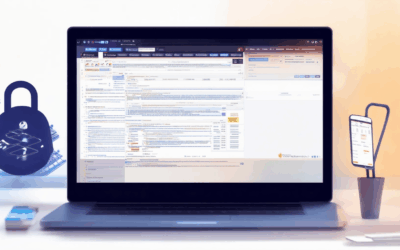In today’s digital age, safeguarding your privacy has become more critical than ever. With personal data scattered across countless platforms and services, it’s easy to feel overwhelmed by the sheer amount of information we share online daily. Whether it’s sensitive financial details, private conversations, or simply your everyday habits, the digital footprint we leave behind can be vulnerable to those who seek to exploit it. Understanding how to protect your privacy online is no longer optional—it’s a necessity. This guide will walk you through the essential strategies, tools, and practices to maintain your digital integrity, ensuring your personal information remains secure and out of harm’s way. From setting up robust privacy settings to adopting safer browsing habits, we’ll explore proven methods to stay ahead of potential threats and take control of your online presence. Let’s dive into the world of digital privacy tips and tricks that every modern user needs to know.
Key Takeaways
– Use Complex Passwords and Store Them Securely: Strong passwords are your first line of defense against cyber threats.
– Enable Two-Factor Authentication for Extra Protection: Add an extra layer of security to guard your accounts.
– Encrypt Sensitive Information to Prevent Unauthorized Access: Safeguard your data with robust encryption methods.
– Avoid Leaving a Trace Online: Clean up unused accounts and steer clear of suspicious links to minimize your digital footprint.
– Use Privacy-Focused Browsers Like BlindBrowser: Opt for browsers designed to protect your anonymity and security.
– Enable Privacy Settings to Reduce Data Collection: Tame the amount of data trackers have access to with built-in privacy tools.
– Implement a VPN for Anonymity and Security: Mask your IP address and encrypt your activities for enhanced privacy.
– Limit Device Usage to Minimize Traces: Use fewer devices for sensitive tasks to reduce the risk of leaving behind digital trails.
– Remove Metadata to Avoid Revealing Location Data: Erase unnecessary files and stay off the map online.
– Select Services That Respect Your Privacy: Choose platforms that prioritize user privacy to keep your data safe.

How to Protect Your Digital Privacy
Protecting your digital privacy is essential in today’s increasingly connected world. Here are some practical steps to safeguard your online identity and personal information:
- Be Mindful of Online Activity Tracking: Many websites track your online activity, from browsing habits to search queries. Use privacy-focused browsers and tools to minimize data collection. For instance, BlindBrowser offers resources to help you understand and control your online footprint.
- Limit Data Collection: Avoid sharing unnecessary personal information online. Be cautious when filling out forms or interacting with websites. Only provide information that is relevant and necessary, such as payment details when making purchases.
- Secure Your Devices: Enable encryption and strong password protection for your devices. Use biometric authentication where possible to add an extra layer of security. Regularly update software to patch vulnerabilities that could expose your data.
- Avoid Public Wi-Fi Risks: Public Wi-Fi networks can be insecure, making your devices vulnerable to cyberattacks. Stick to private networks or use a VPN when connecting to public Wi-Fi to encrypt your data transmission.
- Manage Third-Party App Permissions: When using apps, review and limit the permissions they request. Uninstall apps you no longer use to reduce unnecessary access to your device and data.
- Use Strong, Unique Passwords: Create complex passwords for every account and use a password manager to keep track of them securely. Avoid reusing passwords across multiple platforms to prevent unauthorized access.
By following these steps, you can enhance your digital privacy and reduce the risk of data breaches. Remember to stay informed about emerging threats and adapt your security measures accordingly. For more detailed guidance, explore resources and tools available at BlindBrowser .
The Three Pillars of Digital Privacy
The concept of digital privacy is built upon three fundamental principles, often referred to as the “three pillars” of privacy. These principles ensure that individuals’ personal data remains protected, secure, and accessible only to authorized parties. Below is a breakdown of each pillar:
- Confidentiality
Confidentiality ensures that sensitive information is protected from unauthorized access. This principle revolves around the idea that personal data should only be shared with trusted entities or for legitimate purposes. Laws such as the General Data Protection Regulation (GDPR) in Europe and the California Consumer Privacy Act (CCPA) in the U.S. enforce strict rules around data collection and usage. To maintain confidentiality, organizations often implement encryption, secure storage solutions, and access controls. - Integrity
Integrity refers to the accuracy and trustworthiness of data. It ensures that data has not been altered or corrupted by unauthorized parties. This is particularly important in scenarios like financial transactions or healthcare records, where inaccuracies can have severe consequences. Technologies like encryption and hashing play a vital role in maintaining data integrity, while protocols like blockchain provide a decentralized method of verifying data authenticity. - Availability
Availability ensures that authorized individuals can access their data when needed. While this may seem less critical than confidentiality or integrity, it is equally important. Without access to data, individuals lose the ability to manage their information, track changes, or verify its accuracy. Organizations must balance accessibility with security measures, such as multi-factor authentication and disaster recovery plans, to ensure data remains available without compromising privacy.
By focusing on these three pillars—confidentiality, integrity, and availability—individuals and organizations can work toward creating a secure and trustworthy digital environment. BlindBrowser.com offers comprehensive resources and tools to help users understand and implement these principles effectively. Explore their guides on secure browsing practices and privacy tools to learn more about safeguarding your digital identity.

What are the 5 rules of staying safe online?
Staying safe online requires consistent habits and awareness. Here are five essential rules:
- 1. Use Strong Passwords : Create unique passwords for every account and avoid reusing personal information like names or birthdays.
- 2. Enable Two-Factor Authentication : Add an extra layer of security to your accounts by enabling two-step verification.
- 3. Keep Software Updated : Regularly update your operating systems, apps, and browsers to patch security vulnerabilities.
- 4. Be Cautious with Personal Information : Refrain from sharing sensitive details like addresses or phone numbers online unless it’s necessary and secure.
- 5. Verify Links and Downloads : Before clicking on links or downloading files, verify the source to avoid phishing or malware risks.
By following these rules, you can significantly enhance your online safety and reduce the risk of security breaches. Always stay informed and take proactive measures to protect your digital presence.
For more resources and tools to enhance your online security, visit BlindBrowser.com .

What is the Most Effective Measure for Protecting Your Digital Privacy?
Protecting your digital privacy requires a multi-layered approach, combining strong habits, tools, and awareness. Here are the most effective measures:
- Use Strong and Unique Passwords:** Create complex passwords for every account using a password manager. BlindBrowser’s password generator ensures each password is unique and secure, reducing the risk of hacking.
- Enable Two-Factor Authentication (2FA):** Add an extra layer of security by enabling 2FA for your critical accounts. This prevents unauthorized access even if your password is compromised.
- Encrypt Your Data:** Use encryption for sensitive information stored on your devices and in communication channels. BlindBrowser’s encrypted messaging feature helps safeguard your conversations.
- Minimize Your Digital Footprint:** Regularly clean up unused accounts and avoid clicking on suspicious links. Using BlindBrowser’s private browsing mode keeps your activities less traceable.
For further assistance, explore BlindBrowser’s privacy tools and digital privacy guide for step-by-step guidance. By adopting these practices, you can significantly enhance your online privacy and security.
How to Leave No Digital Footprint
To leave no digital footprint, follow these organized steps:
- Use Privacy-Focused Browsers: Opt for browsers designed for privacy, such as BlindBrowser , which prioritizes online security and anonymity.
- Enable Privacy Settings: Adjust your browser and device settings to limit tracking and data collection. Many modern browsers offer built-in privacy tools.
- Avoid Data Collection: Refrain from clicking on suspicious links or downloading apps that collect personal data. Stick to well-known, reputable platforms.
- Use a VPN: Implement a Virtual Private Network to mask your IP address and encrypt your internet activity, enhancing your digital privacy.
- Minimize Device Usage: Limit the number of devices you use for sensitive activities to reduce the risk of leaving behind traces.
- Delete Metadata: Remove unnecessary files and data from your devices to prevent metadata from revealing your location or activity.
- Use Privacy-Focused Services: Choose platforms and services that respect user privacy, such as BlindBrowser , ensuring your data is handled securely.

Most Effective Setting for Maintaining Digital Privacy
The most effective setting for maintaining digital privacy is a Virtual Private Network (VPN) . A VPN creates a secure tunnel between your device and the internet, encrypting your data and masking your IP address, making it difficult for third parties to track your online activities. Unlike other tools, a VPN provides comprehensive privacy protection by combining encryption, anonymity, and secure connections, ensuring your digital footprint remains hidden from unwanted observers.




